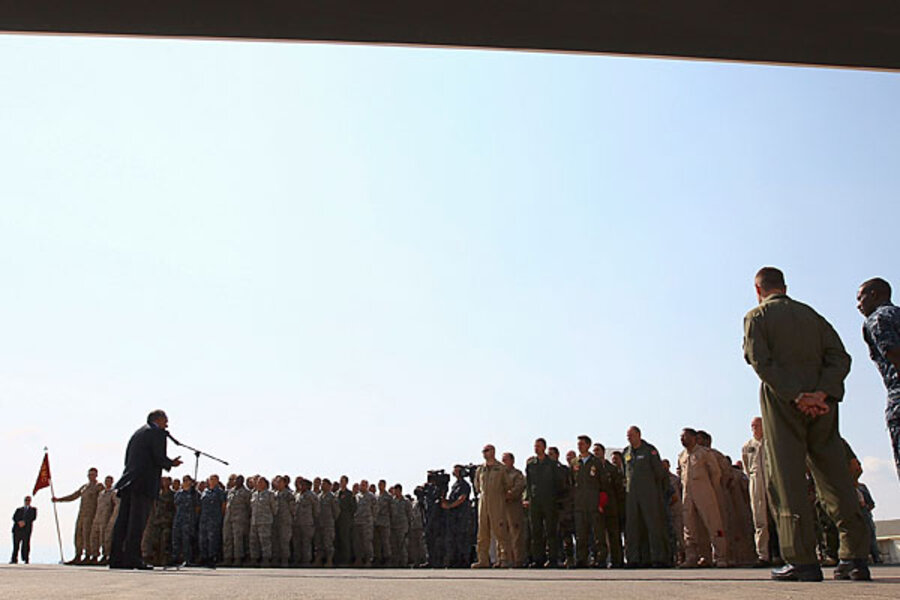Can Libya really be a 'model' for future US military action?
Loading...
| Washington
US officials are heralding the NATO operation that hastened the demise of ousted leader Muammar Qaddafi, as well as the triumph of rebel forces, as “the model” for US military operations in the years to come.
“The NATO alliance worked like it was designed to do – burden-sharing. In total, it cost us $2 billion, no American lives lost. We carried the burden a lot of other places where NATO is – the primary burden like in Afghanistan – and this was really burden-sharing,” Vice President Joe Biden told CNN. “That’s the model.”
The key for the Pentagon in an era of budget cuts and fewer troops, in other words, is likely to be low-cost operations combined with increasingly robust partnerships.
In this model, too, US military officials emphasized the limited nature of the intervention – to the point where US commanders said the operation could be considered complete well before Mr. Qaddafi was found or killed.
“The fact that he is still at large someplace is really more a matter for the Libyans than it is for anybody else,” Gen. Carter Ham, head of US Africa Command, told reporters in early October.
Indeed, in contrast to the US venture in Afghanistan, which at times included women's rights and a robust democracy in its aims, the Libyan mission outlined by Defense Secretary Leon Panetta was comprised of four highly specific goals:
- Putting an end to Qaddafi’s nationwide command and control capability.
- Ending the Qaddafi regime’s ability to attack its citizens.
- Defeating loyalist militias in Qaddafi’s hometown of Sirte.
- Ensuring that rebel forces will be able to keep the nation and its citizens secure.
It is that last point that may require some work in the months to come, US defense officials acknowledge. This could include Libyan security-force training, likely from a combination of forces provided by the international community.
“They do need to take additional steps to make sure that in the long term they can cover the country and maintain security,” said a senior US defense official.
This will not necessarily be part of the NATO mission. “There is the view in some quarters that NATO helped break [Libya] and now NATO owns it," says Stephen Flanagan, a foreign-policy expert at the Center for Strategic and International Studies. "I don’t think that’s the view within the alliance, though there may be a view for NATO to help transform aspects of their security sector.”
US Africa Command may take the lead in such retraining. “They may work with regional partners to see how they can help transform the police – especially since the police have been seen as an instrument of Qaddafi’s repression,” Mr. Flanagan adds.
It is important to see precisely what sort of help the National Transitional Council (NTC) might want from the United States, said Ham in October. He suggested that other African forces or Arab nations might be better suited to training Libyan security forces, though he hinted that the US might take a role in helping to reestablish Libya’s Coast Guard and maritime domain.
Some NATO forces will continue to provide overwatch initially. “We don’t want to go from what’s there now to zero overnight,” Ham said. “There will be some missions that will need to be sustained for some period of time, if for no other reason than to offer assurances to the interim government for things like border security, until such time that they are ready to do all that themselves.”
But the Pentagon is likely to guard against a gradual expansion of its mission, and for now, the supreme allied commander of NATO, Adm. James Stavridis, is on the verge of recommending that operations in Libya cease. He called news of Qaddafi’s death a “good day for NATO,” but a “great day for the people of Libya.”
It is that latter point that US defense officials have sought to emphasize. “The Obama administration has tried to be cautious," says Flanagan. "Yes, it supports more representative government and would like to see democracy flourishing, but it’s not coming with such a heavy footprint to say, ‘Here’s your 10-point plan for achieving it.’ ”
And though the NTC might ask NATO countries for some help, “They’re smart enough to know that the West is not in a big position for offering assistance,” given the plight of many national economies, adds Flanagan.
While Libya is likely to remain a model for the Obama administration’s military operations going forward, Flanagan notes that Libya was unique in some respects. One important factor, for example, was that Libya is close to NATO operating bases.
“I think it’s certainly one model, but it may not be quite as easy, relatively speaking. It was relatively limited in terms of cost, in terms of the fact that there were no NATO casualties, and no significant losses of equipment,” Flanagan adds. “It may not be quite so simple in the future.”





